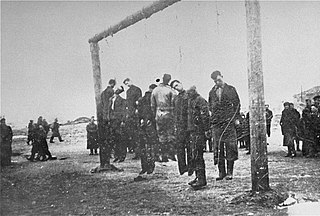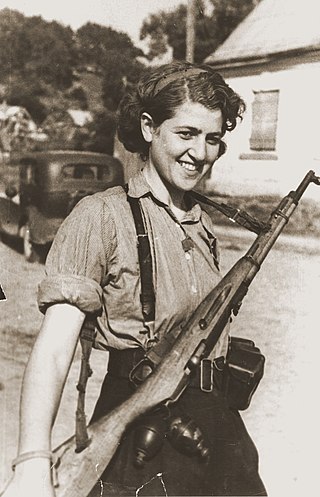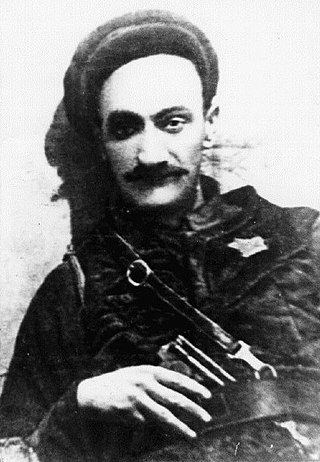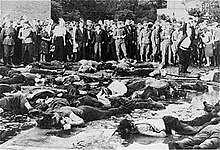
The Vilna Ghetto was a World War II Jewish ghetto established and operated by Nazi Germany in the city of Vilnius in the modern country of Lithuania, at the time part of the Nazi-administered Reichskommissariat Ostland.

The Lwów Ghetto was a Nazi ghetto in the city of Lwów in the territory of Nazi-administered General Government in German-occupied Poland.
The history of the Jews during World War II is almost synonymous with the persecution and murder of Jews which was committed on an unprecedented scale in Europe and European North Africa. The massive scale of the Holocaust which happened during World War II greatly affected the Jewish people and world public opinion, which only understood the dimensions of the Final Solution after the war. The genocide, known as HaShoah in Hebrew, aimed at the elimination of the Jewish people on the European continent. It was a broadly organized operation led by Nazi Germany, in which approximately six million Jews were murdered methodically and with horrifying cruelty. Although the Holocaust was organized by the highest levels of the Nazi German government, the vast majority of Jews murdered were not German, but were instead residents of countries invaded by the Nazis after 1938. Of the approximately 6 million Jews murdered by the Nazis, approximately 160,000 to 180,000 were German Jews. During the Holocaust in occupied Poland, more than one million Jews were murdered in gas chambers of the Auschwitz concentration camp alone. The murder of the Jews of Europe affected Jewish communities in Albania, Austria, Belarus, Belgium, Bosnia & Herzegovina, Channel Islands, Croatia, Czech Republic, Estonia, France, Germany, Greece, Hungary, Italy, Latvia, Libya, Lithuania, Luxembourg, Moldova, the Netherlands, North Macedonia, Norway, Poland, Romania, Russia, Serbia, Slovakia, and Ukraine.

Jewish resistance under Nazi rule took various forms of organized underground activities conducted against German occupation regimes in Europe by Jews during World War II. According to historian Yehuda Bauer, Jewish resistance was defined as actions that were taken against all laws and actions acted by Germans. The term is particularly connected with the Holocaust and includes a multitude of different social responses by those oppressed, as well as both passive and armed resistance conducted by Jews themselves.

Jewish partisans were fighters in irregular military groups participating in the Jewish resistance movement against Nazi Germany and its collaborators during World War II.

The Kaunas pogrom was a massacre of Jews living in Kaunas, Lithuania, that took place on 25–29 June 1941; the first days of Operation Barbarossa and the Nazi occupation of Lithuania. The most infamous incident occurred at the garage of NKVD Kaunas section, a nationalized garage of Lietūkis, an event known as the Lietūkis Garage Massacre. There several dozen Jewish men, allegedly associates of NKVD, were publicly tortured and executed on 27 June in front of a crowd of Lithuanian men, women and children. The incident was documented by a German soldier who photographed the event as a man, nicknamed the "Death Dealer", beat each man to death with a metal bar. After June, systematic executions took place at various forts of the Kaunas Fortress, especially the Seventh and Ninth Fort.
Ephraim Oshry, was an Orthodox rabbi, posek, and author of The Annihilation of Lithuanian Jewry. He was one of the few European rabbis to survive the Holocaust.

The Holocaust in Lithuania resulted in the near total eradication of Lithuanian (Litvaks) and Polish Jews in Generalbezirk Litauen of the Reichskommissariat Ostland in the Nazi-controlled Lithuania. Of approximately 208,000–210,000 Jews at the time of the Nazi invasion, an estimated 190,000 to 195,000 were killed before the end of World War II, most of them between June and December 1941. More than 95% of Lithuania's Jewish population was murdered over the three-year German occupation, a more complete destruction than befell any other country in the Holocaust. Historians attribute this to the massive collaboration in the genocide by the non-Jewish local paramilitaries, though the reasons for this collaboration are still debated. The Holocaust resulted in the largest loss of life in so short a period of time in the history of Lithuania.

Mother Bertranda, O.P., later known as Anna Borkowska, was a Polish cloistered Dominican nun who served as the prioress of her monastery in Kolonia Wileńska near Wilno. She was a graduate of the University of Kraków who had entered the monastery after her studies. During World War II, under her leadership, the nuns of the monastery sheltered 17 young Jewish activists from Vilnius Ghetto and helped the Jewish Partisan Organization (FPO) by smuggling weapons. In recognition of this, in 1984 she was awarded the title of Righteous among the Nations by Yad Vashem.

The Kaunas massacre of October 29, 1941, also known as the Great Action, was the largest mass murder of Lithuanian Jews.
The Šiauliai or Shavli Ghetto was a Jewish ghetto established in July 1941 by Nazi Germany in the city of Šiauliai in Nazi-occupied Lithuania during the Holocaust. The ghetto comprised two areas – one in the Kaukazas suburb and one on Trakai Street. Both were liquidated by July 1944, and their inhabitants were killed or transferred to Nazi concentration camps. In 1939, one quarter of the population of Šiauliai was Jewish, about 8,000 persons. By the end of World War II, only about 500 Jews of the city had survived.

Shlomo Shafir (1924–2013) was an Israeli journalist and historian. His work included the underground Hebrew-language publication Nitzotz, circulated in the Kovno Ghetto and Dachau concentration camp; the Israeli Labor Party newspaper, Davar; and other Hebrew, German, and English language writings.

Cemach Feldstein ([t͡ʃɛɱɑħ fɛldstajn]; sometimes spelled Tzemach; Hebrew: צמח פלדשטיין; Yiddish: פעלדשטיין; Lithuanian: Feldsteinas; Russian: Семён Григорович Фельдштейн, Semyon Grigorovitch; December 30, 1884 - December 29, 1944 was a Lithuanian educator, author, an education reformist, a culture Zionist activist. As an educator he was served as the director of several Jewish gymnasiums, the most notable of which was the Hebrew Real-Gymnasium in Kaunas, Lithuania, where most of the subjects were taught in Modern Hebrew.

Sara Ginaite-Rubinson was a Jewish Lithuanian-born Canadian author and academic. During the Second World War she was a resistance fighter during the Nazi occupation of Lithuania, becoming a Jewish partisan in 1942.
Bruno Kittel was an Austrian Nazi functionary in the German SS and Holocaust perpetrator who oversaw the liquidation of the Vilna Ghetto in September 1943. Kittel became known for his cynical cruelty. He disappeared after the war.

Chaim Yellin was a Lithuanian Yiddish-language poet and leader of the resistance movement in the Kovno Ghetto during the German occupation of Lithuania.

Esther Lurie was an Israeli painter.

This article presents the timeline of selected events concerning the history of the Jews in Lithuania and Belarus from the fourteenth century when the region was ruled by the Grand Duchy of Lithuania.

Elena Kutorgienė was a Lithuanian physician who resisted the Nazi occupation of Lithuania during World War II. Kutorgienė and her son took Jewish children out of the Kovno Ghetto and placed them in gentiles' homes to save them from genocide. She is recognized as Righteous Among the Nations.
Avraham Tory (1909–2002) was a Jewish Lithuanian Holocaust survivor, diarist, and lawyer.

















